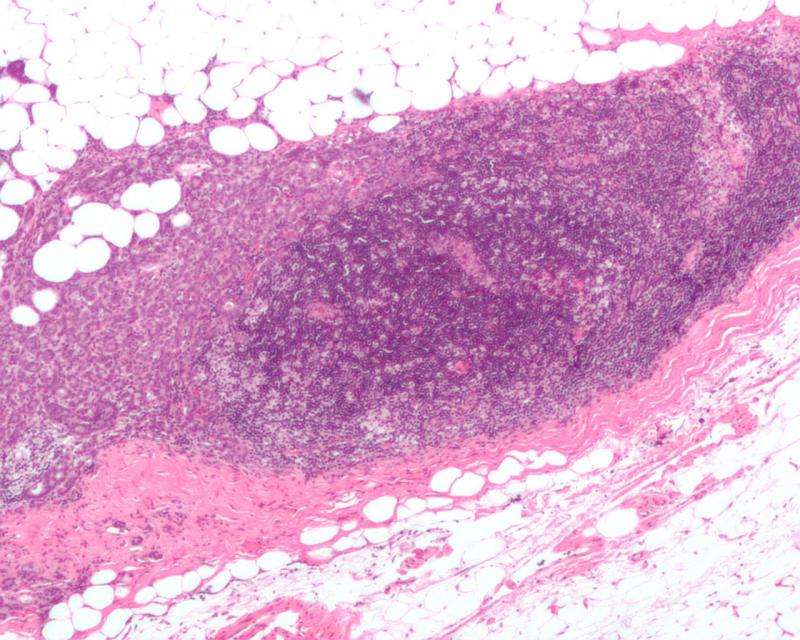Micrograph showing a lymph node invaded by ductal breast carcinoma, with extension of the tumour beyond the lymph node. Credit: Nephron/Wikipedia
Breast cancer is the most common cancer type in women in Sweden and worldwide. It has long been known that not all breast cancers are similar: Luminal tumours consist mostly of cells that are similar to those found in the inner lining of the breast ducts (luminal mammary gland cells), whereas others can have cells more similar to the outer layer of the breast epithelium (basal cells). It is believed that this diversity originates from mutations in different stem cells or progenitor cells. The identities of these peculiar progenitor cell populations and their tumour forming capabilities are incompletely understood.
In a new study, published in Nature Cell Biology, researchers at Karolinska Institutet describe rare populations of basal and luminal progenitor cells that contribute to normal mammary gland development and serve as tumour-initiating cells specifically for luminal breast cancers.
The newly discovered progenitor cell populations express Lgr6, a cell surface receptor protein that is commonly associated with stem cells in the hair follicle, skin, lung, and tongue.
Marker for mammary gland progenitor cells
The research group at the Department of Biosciences and Nutrition at Karolinska Institutet in Huddinge, led by Leander Blaas and Rune Toftgård, teamed up with researchers at the Crick Institute in London to isolate and analyze progenitor cells marked by the receptor Lgr6 during normal mammary gland development and the development of tumours.
Using a genetic mouse model, in which these cells can be labelled with a fluorescent protein, the research team could show that Lgr6+ cells expand during puberty and help to build the organ. Once the mammary gland is fully developed, Lgr6+ cells do not seem to play an active role in maintaining the epithelium. During pregnancy, however, they surprisingly become reactivated and help to form the milk-producing structures (alveoli). Although, Lgr6-expressing cells only comprise ~2 – 4 % of all mammary gland epithelial cells, their progeny contribute substantially to the organ's development and it's main function, the production of milk.
Needed for efficient tumour growth
Parallel to their analyses of Lgr6+ cells in normal development, the researchers tested whether mutations in these cells could result in the formation of mammary gland tumours. When they induced two different combinations of mutations in these cells, luminal tumours appeared in both mouse models, suggesting that rare Lgr6+ cells are potent cells of origin for breast cancer. Next, they traced Lgr6-expressing cells in different mouse models of basal and luminal breast cancer. These experiments revealed a specific contribution to development and maintenance of luminal mammary gland tumours.
Strikingly, when they depleted Lgr6+ cells in a mouse model of luminal breast cancer, the resulting tumours appeared later, were smaller, and appeared to be less aggressive.
"Lgr6+ cells are rather rare and still, they seem to fuel luminal tumour growth and strongly affect the composition of a tumour", says Leander Blaas, a lead author of the study. "In a next step, we want to perform a detailed, molecular characterization of these cells in normal mammary glands and in tumours. Most progenitor and tumour-initiating cells are isolated using very broad and non-specific markers. Using Lgr6 as a marker, we are able to specifically isolate and characterize such cells and determine their properties."
The Lgr6 receptor is expressed in approximately 50% of human breast cancers and its overexpression may be associated with patient survival. Thus, this work will also benefit research into human breast cancer and therapies targeting tumour-maintaining cells.
More information: Leander Blaas et al. Lgr6 labels a rare population of mammary gland progenitor cells that are able to originate luminal mammary tumours, Nature Cell Biology (2016). DOI: 10.1038/ncb3434
Journal information: Nature Cell Biology
Provided by Karolinska Institutet





















